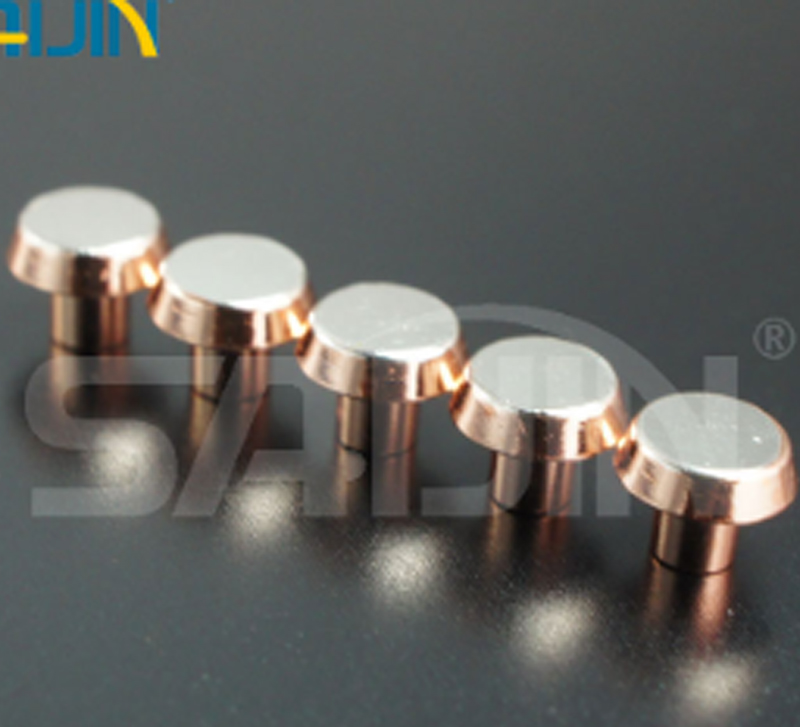Factors Affecting the Lifespan of Bimetal Rivet Contacts
Bimetal rivet contacts play a crucial role in many electrical devices, and understanding the factors that influence their lifespan is essential for ensuring the reliable operation of these devices. Their lifespan can be affected by a variety of elements, which are discussed in detail below.

I. Material - related Factors
A. Composition of the Bimetal
The two different metals used in bimetal rivet contacts have distinct properties, and their combination significantly impacts the lifespan. For example, if one metal has a high coefficient of thermal expansion and the other has a low one, during temperature changes, the bimetal strip will bend. This continuous bending and straightening during operation can cause stress on the rivet contacts. Over time, repeated stress may lead to fatigue failure, shortening the lifespan. Additionally, the corrosion resistance of the metals matters. If the metals are prone to corrosion in the operating environment, the contact surface may degrade, increasing contact resistance and ultimately reducing the lifespan of the bimetal rivet contacts.
B. Purity and Quality of the Materials
High - purity materials are essential for long - lasting bimetal rivet contacts. Impurities in the metals can act as weak points, accelerating the formation of cracks or corrosion. For instance, even a small amount of impurity in a metal used for the contact can lead to localized galvanic corrosion when in contact with other substances in the electrical circuit. This corrosion can gradually erode the contact, reducing its effectiveness and lifespan. High - quality materials also ensure better mechanical and electrical properties, such as higher electrical conductivity and better resistance to wear, which contribute to a longer lifespan.
II. Working Environment Factors
A. Temperature
Temperature is a major factor. High - temperature environments can cause the metals in the bimetal rivet contacts to expand and contract repeatedly. This thermal cycling can lead to mechanical stress and fatigue. In extreme cases, high temperatures can even cause the metals to soften or melt, destroying the integrity of the contact. On the other hand, low - temperature environments can make the metals more brittle, increasing the risk of cracking when the contacts are subject to mechanical forces or electrical arcing.
B. Humidity and Moisture
Humid or moist environments pose a significant threat to the lifespan of bimetal rivet contacts. Moisture can promote corrosion, especially when the metals are in contact with oxygen. Rust or other corrosion products can form on the contact surface, increasing the contact resistance. This increased resistance can lead to overheating during electrical operation, further degrading the contacts and shortening their lifespan. In addition, moisture can also cause electrical leakage in some cases, which can damage the contacts and the overall electrical system.
C. Chemical Exposure
Exposure to chemicals, such as acids, alkalis, or solvents, can have a detrimental effect on bimetal rivet contacts. Chemical reactions can occur between the metals and these substances, leading to corrosion, dissolution, or the formation of insulating layers on the contact surface. For example, if the bimetal rivet contacts are used in an industrial environment where they are exposed to acidic fumes, the metal surfaces can be quickly corroded, reducing the contact's conductivity and lifespan.
III. Usage - related Factors
A. Electrical Load
The electrical load passing through the bimetal rivet contacts is a critical factor. High - current applications can generate significant heat due to the resistance of the contacts. This heat can cause the metals to expand, deform, and even melt if the current exceeds the rated capacity for an extended period. Electrical arcing, which occurs when the contacts open and close under high - current conditions, can also erode the contact surface, reducing its lifespan. Even in low - current applications, repeated switching can cause wear and tear on the contacts over time.
B. Frequency of Operation
The more frequently the bimetal rivet contacts are opened and closed, the more wear and tear they experience. Each operation can cause mechanical stress on the rivets and electrical arcing at the contact points. Over time, this repeated stress and arcing can lead to pitting, erosion, and eventually failure of the contacts. In applications where the contacts are switched rapidly, such as in some types of relays, the lifespan of the bimetal rivet contacts may be significantly shorter compared to applications with less frequent operation.
In conclusion, the lifespan of bimetal rivet contacts is influenced by a combination of material - related, working - environment, and usage - related factors. By carefully considering and controlling these factors, manufacturers and users can improve the reliability and lifespan of bimetal rivet contacts in various electrical applications.




